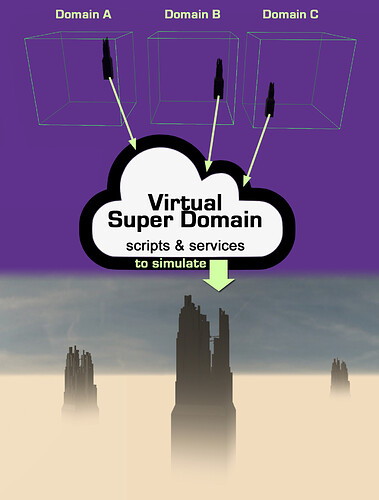Introducing the concept of “Virtual Super Domain”…
Imagine a world where you have different places in it. It could be, for example, a large piece of land, with many villages on it.
Each of these “villages” would share a same landscape, a same water surface and a same sky.
From your village in this world, you could see the other villages at some distance from your. You can even walk or fly to these other villages.
Now, imagine that each of those village are in reality hosted on different domains. So from any of these villages, you won’t be affected by the content or the communication bandwidth of the other villages, each village having it’s own domain server.
Imagine also a super-structure that allows those places, hosted from different domains, to be under present in a same consistent world. We could call that a “super domain”.
A super domain offers some advantages:
- It organizes a world based one a same theme shared by its community.
- It comes with an ecosystem that each owner don’t have to worry about. Sky, landscape, day/night cycle, teleportation management, etc.
- It very fast to setup your place inside this world, offering you a good foundation to build on.
- You can host many independent places in your domain that can be plugged on different theme and community using super domains.
Of course, this is a simulation. But this is good enough to seed in the user brain the idea that all those places are standing in a same world.
The Skyscapers experiment
As a first phase of experimentation. I decided to keep it simple, also I used a simple concept without any walkable landscape.
Basically, each place is the tip of a very tall structure (looking as buildings) where the foundation is lost into a thick layer of fog. These “buildings” are the landscape part of the equation, basically the bedrock that you can build on.
As you can see, each building are visible from each other, even if they are located in different domains, and this is consistent from each of those places.
If you fly to another building, you will be move at a corresponding location on the other domain, discovering the same view, with the same sky, with the same neighbourhood.
Of course, you can’t see all the content from the other domains, only basic building models. You can understand what it would do if we were to render the content of 20 domains in a same one. But this trickery does induce the idea that all those places are standing in a same world.
This experimentation is only a proof of concept. Mainly regarding the overall mechanism, and the deployment of it.
Limited customization:
In this experimentation, a “building” can be customized on the material level only, by overriding the “.fst” file used on the model entity. The system won’t allow to change the model (there are validations if you try), but if you want it to be pink, you can make it pink using the material of the “.fst”, and your neighbourhood will see it pink too.
You can visit the “Skyscapers experiment” by your-self at one these locations:
hifi://24.203.56.96:42102/-8707.26,10041.8,-7475.34/0,0.918577,0,-0.395242
hifi://24.203.56.96:41102/-9310.22,-9644.35,8104.37/0,-0.791098,0,0.611689
hifi://24.203.56.96:43102/7333.57,-7985.36,7361.21/0,0.384612,0,0.923079
You can host your own skyscraper by joining the super-domain here:
What’s next?
In a next experimentation, the following things are planned to be addressed:
- Shared walkable landscape
- Shared water level surface
- Customized content visible from the neighbourhood.
- Day-Night cycle

